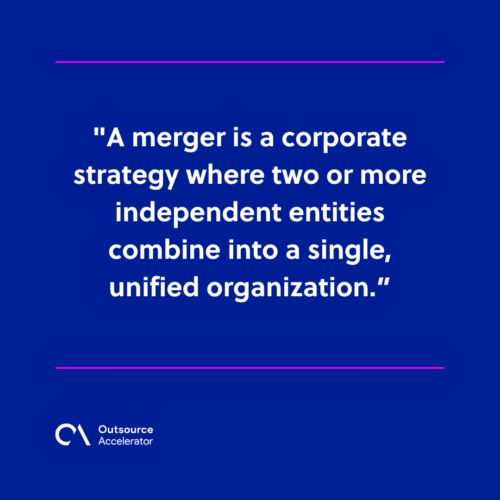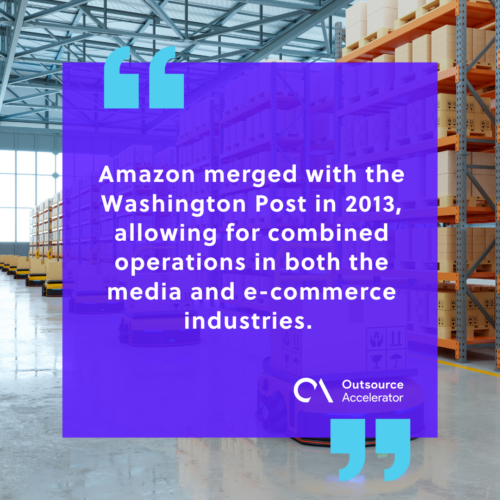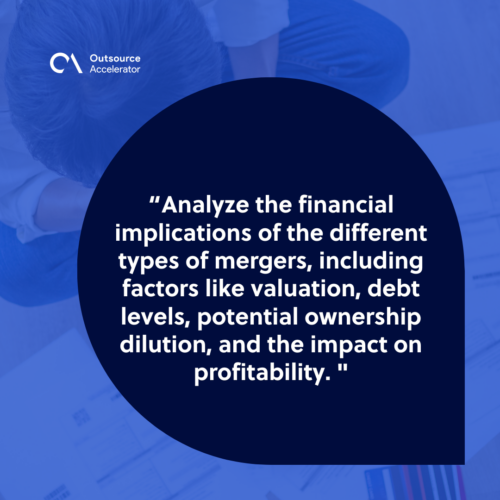Exploring the different types of mergers

When two or more companies decide to join forces and combine their operations, it can often result in a merger.
Mergers have become integral strategic maneuvers for companies. These transformative events actually come in various forms, each with its own unique characteristics and implications.
It’s therefore, crucial for businesses to understand the different options available to them.
In this article, we’ll delve into the various types of mergers, providing a comprehensive overview to help companies learn how these moves shape contemporary business.
What is a merger?
A merger is a corporate strategy where two or more independent entities combine into a single, unified organization. This business move is typically done to achieve various objectives, like:
- Expanding market presence
- Enhancing operational efficiency
- Leveraging synergies
After a merger, the individual entities involved cease to exist independently. The process often involves a negotiation between the merging parties, as well as approval of relevant authorities.
The ultimate goal of mergers is to create a stronger, more competitive entity that can perform more effectively.

How does a merger work?
Mergers are complex processes, and this complexity only increases the larger the companies involved are.
The types of mergers determine the specific steps and intricacies, but generally, here is an outline of how a merger works:
Strategic planning
Companies decide to merge for various reasons, such as:
- Expanding market share
- Achieving cost synergies
- Accessing new technologies
- Diversifying business portfolios
Before formalizing the merger, the parties involved thoroughly examine each other’s financial, operational, and legal aspects. This allows them to gain a good understanding of risks and opportunities.
Negotiation and agreement
The merging companies then negotiate the terms, including which among the types of mergers they’ll pursue. Once these are determined, legal documents like the merger agreement are drafted and signed by both parties.
Other terms that are also usually discussed include:
- Stock exchange ratio
- Asset valuation
- Structure of the new entity
Regulatory approval
Shareholders of each company then vote on the proposed merger.
In many cases, regulatory authorities also review the merger to ensure it complies with antitrust laws. During these types of mergers, they also want to avoid the creation of a monopoly or promote anti-competitive practices.
Integration planning
Detailed plans are developed to integrate operations, technology, and personnel. This stage also involves aligning corporate cultures to foster a harmonious working environment.
Implementation
The merger is officially completed. This is also referred to as the closing date. The assets and liabilities of the merging companies are transferred to the new entity per the terms of the agreement.
Post-merger activities
Two ongoing post-merger activities are crucial.
First, there must be transparent communication between employees, customers, and other stakeholders to maintain trust and manage expectations.
Second, continuous monitoring of the integrated operations and adjusting as necessary will ensure a smooth transition.
No matter the type of merger, legal and financial advisors play crucial roles throughout the entire process. The success of a merger often hinges on their advice regarding planning, communicating, and executing integration plans.
Merger vs. Acquisition
A merger and an acquisition are both strategic business moves that revolve around combining resources, operations, and ownership. However, they differ in their structure, purpose, and the degree of integration between the involved entities.
As stated, in a merger, two companies come together to form a new entity. The two companies are considered equals, and the partnership is seen as collaborative.
There is a high degree of integration between the two as they share assets, resources, and operations.
On the other hand, an acquisition is when one company purchases another. The target company may continue to exist as a subsidiary or be fully absorbed by the acquiring company.
Acquisitions tend to have a more hierarchical structure, with one company taking on a dominant role. The level of integration in an acquisition can vary.
Here’s a table outlining the key differences between the two:
| Merger | Acquisition | |
| Survival of identity | Creates a new entity, and the originals cease to exist | Acquiring company maintains its identity; the target company may continue as a subsidiary or be fully integrated |
| Collaboration vs. Control | Viewed as a more collaborative process, with both parties contributing and benefiting | Involves a more dominant, controlling role for the acquiring company |
| Purpose | Driven by a desire for mutual benefits, such as synergies, market presence, and diverse offerings | Motivated by various factors, including gaining market share, eliminating competition, or accessing specific assets |
| Terms | The groups involved are referred to as “merging companies” or “parent companies” | The dominant company is termed the “acquirer” or “buyer,” while the smaller company is the “target” or “seller” |
Different types of mergers
There are several types of mergers, each characterized by the relationship between the companies involved and the strategy behind the consolidation.
The main types of mergers include the following:
Horizontal merger
This type of merger occurs when two companies that operate in the same industry and at the same stage of the production process combine.
Horizontal mergers are ideal when you’re seeking to:
- Consolidate market share
- Reduce competition
- Achieve economies of scale
The merger of Exxon and Mobil in 1999 is a classic horizontal merger. Both were major players in the oil and gas industry and aimed to combine that success.
Vertical merger
Vertical merger takes place when two companies that are in different stages of the supply chain or production process merge.
These mergers are appropriate for businesses looking to streamline operations, improve efficiency, and gain control over the supply chain.
In 2006, the Walt Disney company acquired Pixar Animation Studios, bringing computer-animated filmmaking into its overall entertainment strategy.
Conglomerate merger
Conglomerate mergers involve the coming together of companies that do different activities from unrelated industries.
Diversification is a key goal in this type of merger, allowing the merged entity to benefit from a broadened portfolio and reduced business risk.
There are two sub-categories of conglomerate mergers:
- Pure conglomerate merger. This occurs when companies from completely different industries merge.
- Mixed conglomerate merger. It is when companies from related but distinct industries merge.
Amazon merged with the Washington Post in 2013, allowing for combined operations in both the media and e-commerce industries.

Market extension merger
This type of merger happens when two companies that operate in the same industry but in different geographic markets merge. The goal is typically to increase market share by reaching into new customer bases.
In 2014, Facebook merged with WhatsApp, allowing it to tap into the latter’s user bases in parts of Europe, Asia, and South America.
Product extension merger
Product extension mergers take place when two companies that sell related but different products merge. This type of merger aims to enhance the product or service offerings of the merged entity, allowing it to cater to a broader range of customer needs.
Apple and Beats Electronics merged in 2014. Apple was able to diversify its products in the audio and music streaming industry.
Reverse merger
Reverse merger involves a private company acquiring a publicly traded company, becoming publicly traded themselves.
The private company thus gains access to the public company’s stock exchange listing without going through the initial public offering (IPO) process.
This type of merger provides a faster and often less expensive way for a private company to become publicly listed.
Lordstown Motors merged with DiamondPeak Holding Corps in 2020, becoming a publicly traded company.
Congeneric merger
Congeneric mergers involve the combining of companies that serve the same customer base but offer different products or services. This results in the merged entity becoming able to cross-sell or bundle products, creating synergies in marketing and distribution.
Procter & Gamble merged with Gillette in 2005. This allowed them to go forward in the consumer goods sector by offering both household and personal care products.
Cash merger
Cash mergers involve the acquiring company paying cash to the shareholders of the target company for their shares. This type of merger is typically used when the acquiring company has substantial cash reserves to quickly obtain the target company.
In 2016, Microsoft paid a significant cash amount to merge with LinkedIn.
Stock-for-stock merger
In a stock-for-stock merger, shareholders of the target company receive shares of the acquiring company’s stock in exchange for their shares. Instead of pure cash, this creates a stock-based acquisition.
In this scenario, the value of the target company is determined by the acquiring company’s stock price. This type of merger is useful for companies that wish to use their stock as currency for acquisitions.
AOL used its stock to merge with Time Warner in 2000.
Hostile merger
This type of merger occurs when the target company is resistant. The acquiring company then proceeds without the target’s approval. This is more commonly referred to as a hostile takeover, and, in practice, is similar to an acquisition.
Hostile mergers are typically driven by the acquirer’s belief in the merger’s strategic benefits, even in the face of opposition from the target company.
A notable example was the attempt by Pfizer to take over fellow pharmaceutical company AstraZeneca in 2014.
These are some of the main types of mergers organizations are most likely to encounter during their life cycles. Note that it’s common to have some overlap in real-life mergers.
Understanding these different types is essential for businesses, investors, and regulators. It provides insights into the diverse motivations and implications associated with each form of corporate consolidation.
What’s the best merger type for your business?
Deciding on the best type of merger depends on a few factors. There isn’t a one-size-fits-all answer, as suitability differs from one business to another.
Here are a few considerations that can help you choose from among the types of mergers:
- Strategic fit – Consider whether the merger will enhance competitive advantage, fill gaps in market reach, or enable diversification.
- Industry dynamics – Evaluate the nature of the industry and market where the business operates, including competition, emerging trends, and potential disruptors.
- Synergy potential – Assess the potential synergies that can be achieved through the merger, such as cost savings, expanded customer base, or access to new technologies.
- Financial considerations – Analyze the financial implications of the different types of mergers, including factors like valuation, debt levels, potential ownership dilution, and the impact on profitability.
- Cultural compatibility – Consider a type of merger that allows for a smoother integration of leadership styles, corporate values, and employee dynamics.

It’s important to conduct a thorough analysis with key stakeholders and professional advice if necessary. Ultimately, the best type of merger is one that aligns with the strategic objectives of the newborn company.







 Independent
Independent




